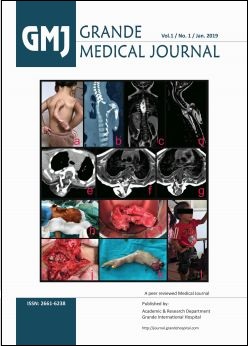Surgical treatment of tuberculosis of spine: Nepalese experience
DOI:
https://doi.org/10.3126/gmj.v1i1.22400Keywords:
Spine, TuberculosisAbstract
Introduction : Spinal tuberculosis treatment goal is eradication of the disease, neurological protection, and deformity prevention. Accepted indications for conservative or surgical management of the disease are still lacking. The purpose of this study was to classify disease based on pre- and post-treatment clinical and radiological criteria to help management.
Material and methods : Out of 101 patients, retrospectively reviewed between 2007 and 2015, seventy adult patients (44 males, mean age 29 years, range 16-76) were included in the study. Patients were evaluated clinically for pain, deformity and neurological status while radiological evaluation included sagittal deformity, vertebra destruction and number of vertebrae involvement. 60 patients underwent surgery (abscess drainage, 2; anterior radical debridement and fusion, 12; anterior debridement + posterior instrumentation, 26; posterior instrumentation, 20) All patients were given anti-tuberculous treatment for 12 months. Mean follow up period was 44.9 months (range: 6-108 months).
Result: Pre-treatment pain (Visual analogue score, VAS 0-10, mean 7.52) improved by 0.99 at last follow up. Number of vertebrae involved ranged from 1 to 15 (mean 4.2). 38 patients had obvious clinical deformity with Cobb angle mean 36.6° (range 10°-130°). Deformity was corrected at mean of 17.5° (range: -60° to 90°) at last follow up.
There were two ASIA A, eight ASIA B, five ASIA C, four ASIA D and 51 patients with ASIA E neurology at the time of presentation. One patient with ASIA A neurology remained same even after decompression while other patient died on the day of surgery. Out of 8 patients with ASIA B neurology six patients improved to ASIA E, one patient remained same and one patient deteriorated to ASIA A. In ASIA C group, three patients improved to ASIA E. One patient deteriorated to ASIA A. All four patients with ASIA D neurological status improved to ASIA E. And all 51 patients with pre-operative ASIA E status remained same but one deteriorated to ASIA C.
Eight patients had deformity progression, two patients had deep vein thrombosis, two patients had superficial wound infection and one patients had recurrent cold abscess. Two patients died due to associated co-morbidities.
Based upon the clinical and radiological pre- and post-operative findings; Uncomplicated spines were managed conservatively or with abscess drainage (USG or CT – guided). Complicated spines were managed with posterior instrumentation and complex spines were managed with anterior / posterior procedure (posterior only approach)
Conclusion: Based upon the outcome of treatment of spinal tuberculosis, conservative treatment results in healing of the disease process with residual deformity while surgical treatment in selected cases results in early pain alleviation, spinal balance, neurologic protection and eventually early return to work.
Downloads
Downloads
Published
How to Cite
Issue
Section
License




